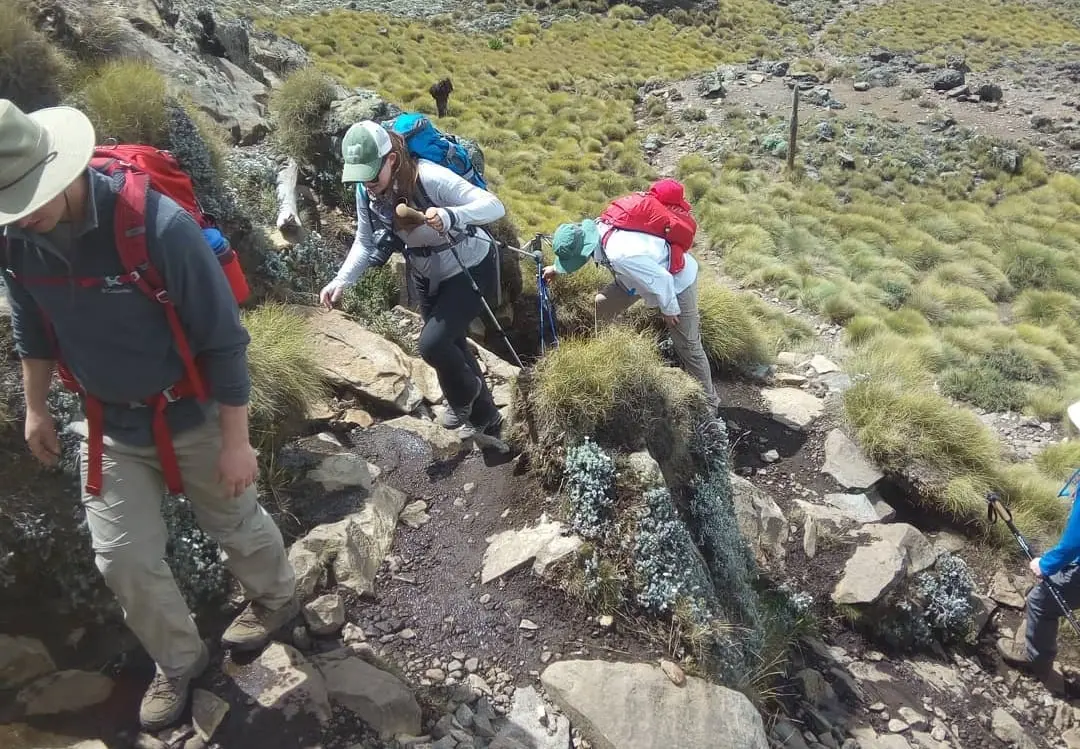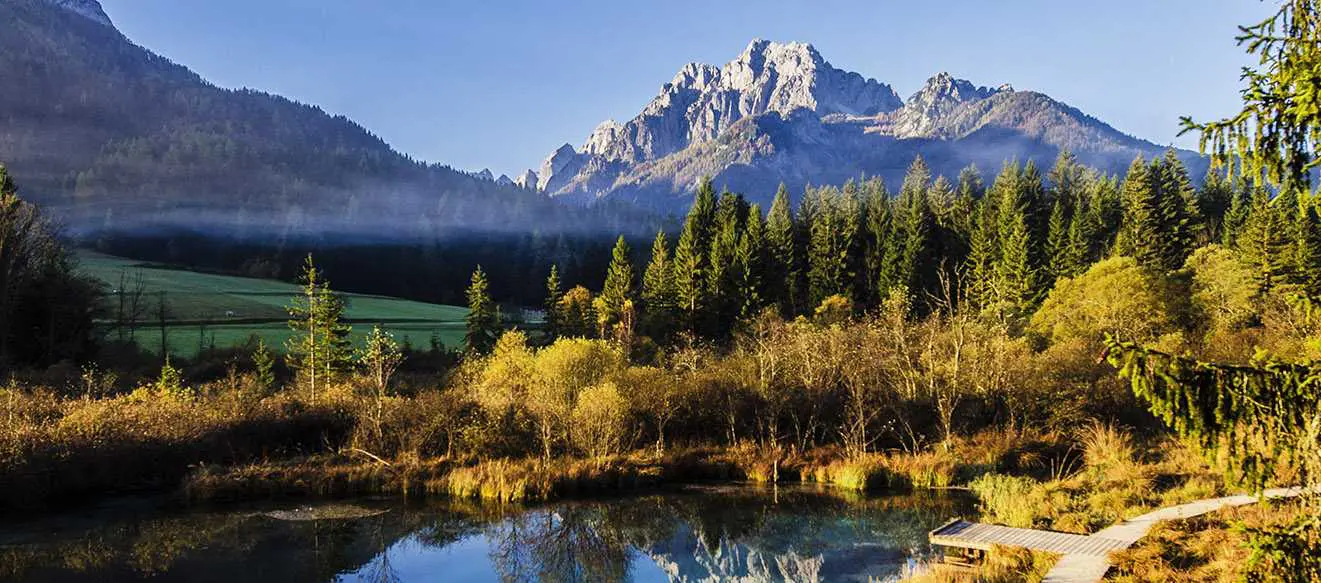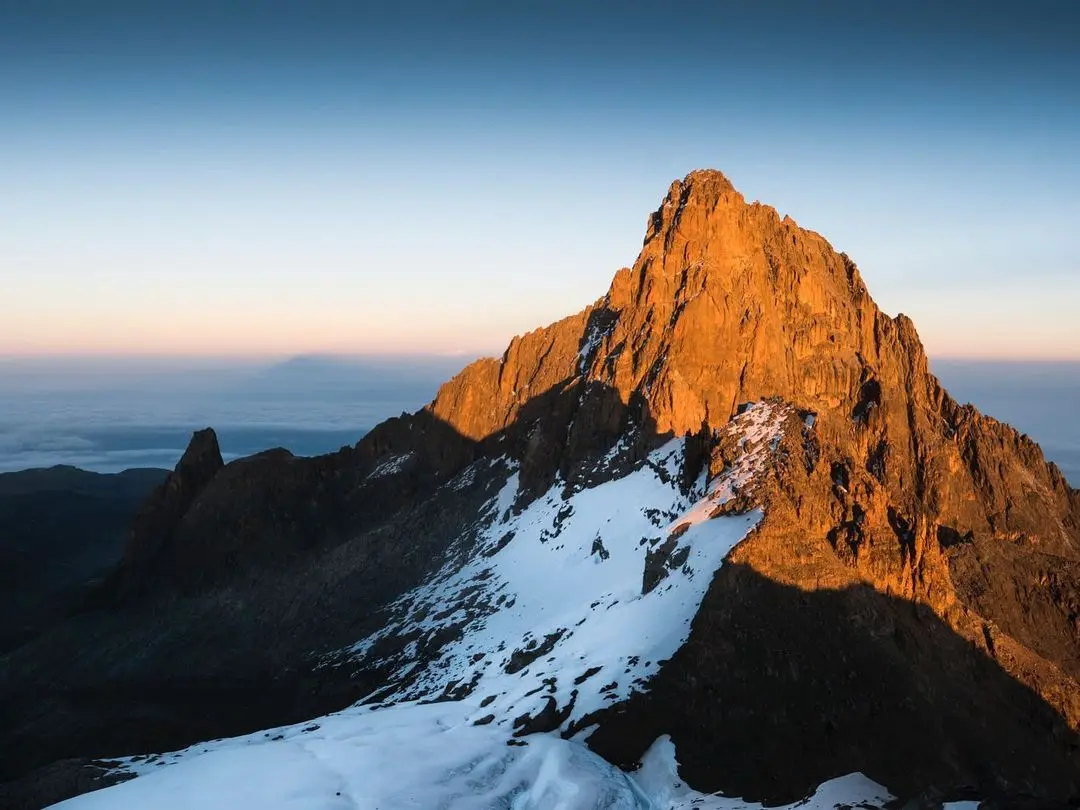Mount Kenya's highest peak is Batian, which stands at 5,199
meters (17,057 feet). This formidable summit is a technical climb, renowned for
its challenging rocky slopes. The second highest peak is Nelion peak and it reaches 5,188 meters
(17,021 feet). Nelion peak of Mount Kenya is similarly demanding for climbers.
Separated from Batian by the Gates of Mist gap, Nelion presents an equally
thrilling adventure. The third highest peak is Point Lenana, which rises to
4,985 meters (16,355 feet). Unlike Batian and Nelion, Point Lenana is
accessible to trekkers without technical climbing skills, making it the most
frequently ascended peak.
Other notable peaks on Mount Kenya include Point Piggot,
Point Dutton, Point John, Krapf Rognon, Midget Peak, Terere, and Sendeyo. Each
of these peaks offers its own unique challenges and rewards, attracting
climbers from all over the world.
1. Batian Peak (5,199 meters / 17,057 feet)
Batian, standing at 5,199 meters (17,057 feet), is the
highest peak of Mount Kenya and one of the most challenging climbs on the
continent. Named after Mbatian, a renowned Maasai Laibon (medicine man), this
peak demands advanced climbing skills due to its steep, rocky slopes and
technical routes.
Climbing Batian
Climbing Batian is a formidable endeavor, typically
requiring a combination of rock climbing and ice climbing skills. The standard
route to the summit is the North Face Standard Route, which is about 18 pitches
of rock climbing. Climbers must navigate through a mix of granite and gneiss,
making the ascent both physically demanding and technically complex.
Historical Climbs Batian Peak
The first recorded ascent of Batian was made by Halford
Mackinder, C. Ollier, and J. Brocherel on September 13, 1899. This historic
climb marked a significant achievement in mountaineering, showcasing the peak's
challenging nature.
Preparation and Gear
Due to its technical nature, climbers aiming for Batian must
be well-prepared with the appropriate gear. Essential equipment includes ropes,
harnesses, ice axes, crampons, and helmets. Additionally, climbers should have
experience in high-altitude climbing and be prepared for rapidly changing
weather conditions.
Scenic Views and Wildlife
From the summit of Batian, climbers are rewarded with
panoramic views of Mount Kenya's surrounding peaks and valleys. The sight of
glaciers, rugged terrain, and diverse wildlife, including alpine flora and
various bird species, adds to the allure of this peak.
2. Nelion Peak (5,188 meters / 17,021 feet)
Nelion, standing at 5,188 meters (17,021 feet), is the
second highest peak of Mount Kenya. Located just 140 meters away from Batian,
Nelion is often referred to in conjunction with Batian as they are separated by
the narrow Gates of Mist gap. This peak is also named after a Maasai leader,
reflecting the region's rich cultural heritage.
Climbing Nelion
Nelion is known for its technical climbing challenges,
similar to Batian. The South-East Face Standard Route is the most commonly used
path to the summit, consisting of about 21 pitches of rock climbing. Climbers
encounter steep, rocky terrain requiring advanced climbing techniques and
experience. The climb to Nelion is demanding, with the added thrill of
potentially crossing over to Batian via the Gates of Mist.
Crossing the Gates of Mist
The Gates of Mist is a gap that separates Nelion from
Batian, and crossing it is a unique experience. This traverse involves
navigating a short but exposed ridge, adding an extra layer of adventure for
climbers aiming to summit both peaks in a single expedition.
Historical Climbs
Nelion's first ascent was achieved by Eric Shipton and Percy
Wyn-Harris on January 6, 1929. Their climb marked a significant milestone in
the history of mountaineering on Mount Kenya, further highlighting the peak's
technical difficulties and allure.
Preparation and Gear
As with Batian, climbing Nelion requires thorough
preparation and the right equipment. Essential gear includes ropes, harnesses,
helmets, ice axes, and crampons. Climbers should be experienced in
high-altitude and technical rock climbing, and be prepared for sudden weather
changes.
Scenic Views and Wildlife
The ascent of Nelion offers stunning views of Mount Kenya's
rugged landscape, glaciers, and diverse wildlife. Climbers can enjoy the sight
of alpine vegetation, unique rock formations, and various bird species, making
the climb a visually rewarding experience.
3. Point Lenana (4,985 meters / 16,355 feet)
Point Lenana, rising to 4,985 meters (16,355 feet), is the
third highest peak on Mount Kenya. Unlike Batian and Nelion, Point Lenana is
accessible to trekkers without requiring technical climbing skills, making it
the most frequently ascended peak. Its relative accessibility and stunning
panoramic views make it a popular choice among climbers and trekkers alike.
Accessibility and Climbing Routes
Point Lenana can be reached via several trekking routes,
with the most popular being the Sirimon, Chogoria, and Naro Moru routes. These
routes vary in length and difficulty, offering trekkers a range of options
depending on their experience and fitness levels. The trek to Point Lenana typically
takes three to five days, depending on the chosen route and acclimatization
needs.
Best Times to Climb
The best times to climb Point Lenana are during the dry
seasons, from January to February and from July to September. During these
periods, the weather is more stable, and the trails are less muddy, providing a
more enjoyable trekking experience. However, trekkers should always be prepared
for rapid weather changes, common in high-altitude environments.
Preparation and Gear
While Point Lenana does not require technical climbing gear,
trekkers should still be well-prepared with appropriate clothing and equipment.
Essential items include sturdy hiking boots, warm clothing, a waterproof
jacket, a good quality sleeping bag, and a trekking pole. Additionally,
acclimatization is crucial to prevent altitude sickness, so trekkers should
plan for gradual ascent and rest days.
Scenic Views and Highlights
The ascent to Point Lenana offers spectacular views of the
surrounding landscapes, including valleys, glaciers, and other peaks of Mount
Kenya. At the summit, trekkers are rewarded with breathtaking panoramic views
that can extend as far as Mount Kilimanjaro on a clear day. The sight of the
sunrise from Point Lenana is particularly mesmerizing, making the early morning
summit attempt a popular choice.
Wildlife and Flora
Trekkers on the way to Point Lenana can encounter a diverse
range of wildlife and flora. The lower slopes are home to forests with various
tree species, while the higher altitudes feature unique alpine vegetation.
Wildlife sightings may include colobus monkeys, hyraxes, and an array of bird
species, adding to the rich experience of the trek.
4. Point Piggot (4,957 meters / 16,263 feet)
Point Piggot, standing at 4,957 meters (16,263 feet), is one
of the notable peaks on Mount Kenya. This peak offers a challenging climb for
experienced adventurers. It is named after a pioneering explorer and provides
climbers with a unique and rewarding ascent.
5. Point Dutton (4,885 meters / 16,027 feet)
At 4,885 meters (16,027 feet), Point Dutton is another
prominent peak on Mount Kenya. This peak presents climbers with a mix of
technical routes and scenic beauty. It is a popular choice among climbers
seeking to explore the mountain's diverse terrain.
6. Point John (4,883 meters / 16,020 feet)
Point John, reaching 4,883 meters (16,020 feet), is known
for its dramatic landscape and climbing challenges. This peak offers a
technical ascent, attracting climbers who are looking for a demanding and
rewarding experience.
7. Krapf Rognon (4,800 meters / 15,748 feet)
Krapf Rognon, at 4,800 meters (15,748 feet), is named after
Johann Ludwig Krapf, a German missionary and explorer. This peak features
rugged terrain and steep sections, providing a challenging climb for those who
venture to its summit.
8. Midget Peak (4,700 meters / 15,420 feet)
Midget Peak, standing at 4,700 meters (15,420 feet), offers
a relatively accessible climb compared to other peaks on Mount Kenya. It can be
ascended in a single day, making it a great option for climbers with limited
time. Despite its lower elevation, Midget Peak provides rewarding views and an
enjoyable climbing experience.
9. Terere (4,714 meters / 15,466 feet)
Terere, reaching 4,714 meters (15,466 feet), is one of the
craggy outlying peaks on Mount Kenya. Known for its distinctive rugged
features, Terere offers a challenging scramble for experienced climbers. The
peak is often climbed in conjunction with its nearby twin, Sendeyo, providing a
comprehensive climbing adventure.
10. Sendeyo (4,704 meters / 15,433 feet)
Sendeyo, standing at 4,704 meters (15,433 feet), is closely
associated with Terere. The peak's rocky and steep terrain requires skilled
navigation, making it a favorite among seasoned climbers. The combination of
Terere and Sendeyo offers a thrilling and scenic climbing experience,
showcasing the mountain's diverse topography.
11. The Hat (4,639 meters / 15,220 feet)
The Hat, at 4,639 meters (15,220 feet), is named for its
distinctive shape. This peak is part of the mountain's jagged landscape and
provides a moderately challenging climb. The Hat is known for its picturesque
views, including the surrounding peaks and valleys of Mount Kenya.
12. Delamere Peak
Delamere Peak is one of the notable summits within the Mount
Kenya massif. Although its exact elevation is not as widely recorded as the
higher peaks, it provides a significant climbing experience. Named after one of
the early British settlers in Kenya, this peak offers climbers scenic views and
challenging terrain.
13. Macmillan Peak
Macmillan Peak, another prominent feature on Mount Kenya, is
named after a prominent historical figure in Kenya. This peak offers climbers a
mix of technical routes and breathtaking vistas. The climb is known for its
steep sections and rocky outcrops, making it a rewarding challenge for
experienced climbers.
14. Rotundu
Rotundu, part of the diverse Mount Kenya landscape, offers a
unique climbing experience. Known for its distinctive shape and rocky features,
Rotundu attracts climbers looking to explore the less traversed paths of the
mountain. The climb provides stunning views of the surrounding valleys and
peaks, adding to its appeal.
15. Point Peter (4,757 meters / 15,607 feet)
Point Peter is a Mount Kenya peak that stands at 4,757
meters (15,607 feet). Point Perter is one of the notable peaks in the Lewis
Glacier area of Mount Kenya. This peak offers a challenging scramble, with
steep and rugged terrain. Point Peter is known for its dramatic landscape and
the panoramic views it offers from the summit, making it a favorite among
experienced climbers.
16. Point Slade (4,750 meters / 15,584 feet)
Point Slade is 4,750 meters (15,584 feet) high. It offers a
steep and rocky climb. The peak is known for its challenging terrain and
stunning views.
17. Midget Peak (4,700 meters / 15,420 feet)
Midget Peak stands at 4,700 meters (15,420 feet). It can be
climbed in a single day. The peak provides rewarding views and an enjoyable
climbing experience.
18. Terere (4,714 meters / 15,466 feet)
Terere is 4,714 meters (15,466 feet) high. It is one of the
craggy outlying peaks. The climb is challenging and offers rugged features.
Terere is often climbed with its nearby twin, Sendeyo.
19. Sendeyo (4,704 meters / 15,433 feet)
Sendeyo stands at 4,704 meters (15,433 feet). It is closely
associated with Terere. The peak's rocky and steep terrain requires skilled
navigation. It is a favorite among seasoned climbers.
20. Point Melhuish
Point Melhuish is part of the Lewis Glacier area. This peak
provides a mix of technical climbing and scenic beauty. It is named after a
notable figure in Mount Kenya's climbing history.
21. Shipton's Peak
Shipton's Peak is named after Eric Shipton, a famous
mountaineer. It is one of the peaks in the Lewis Glacier area. The climb is
challenging and offers dramatic landscapes and stunning views.
22. Tilman Peak
Tilman Peak is named after Bill Tilman, a well-known
explorer. This peak is also in the Lewis Glacier area. It offers a rugged climb
with technical sections, appealing to experienced climbers.
23. Grigg Peak
Grigg Peak is located in the Lewis Glacier area of Mount
Kenya. This peak offers a technical climb with steep and rocky terrain.
Climbers can enjoy stunning views of the surrounding glaciers and peaks.
24. Sommerfelt Peak
Sommerfelt Peak is another prominent peak in the Lewis
Glacier region. The climb is known for its challenging routes and beautiful
scenery. It attracts experienced climbers looking for a rigorous adventure.
25. Point John Minor (4,875 meters / 15,994 feet)
Point John Minor stands at 4,875 meters (15,994 feet). It is
a lesser-known peak but offers a challenging climb. The peak is known for its
rugged terrain and rewarding views.



